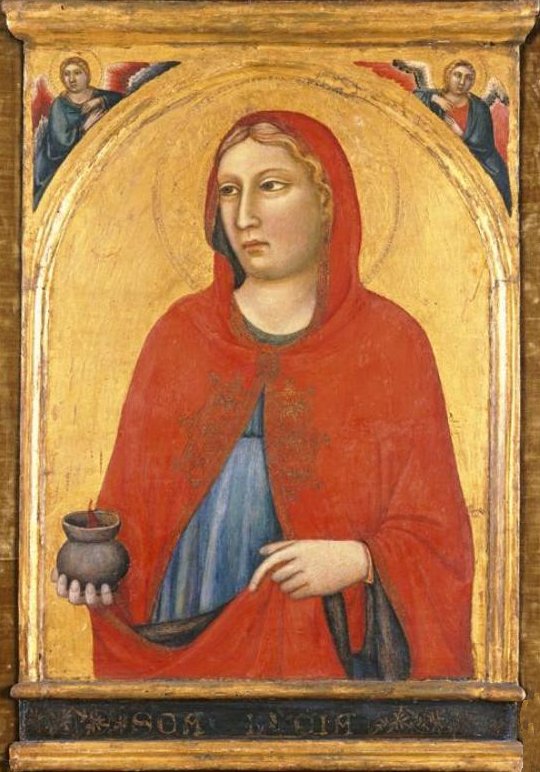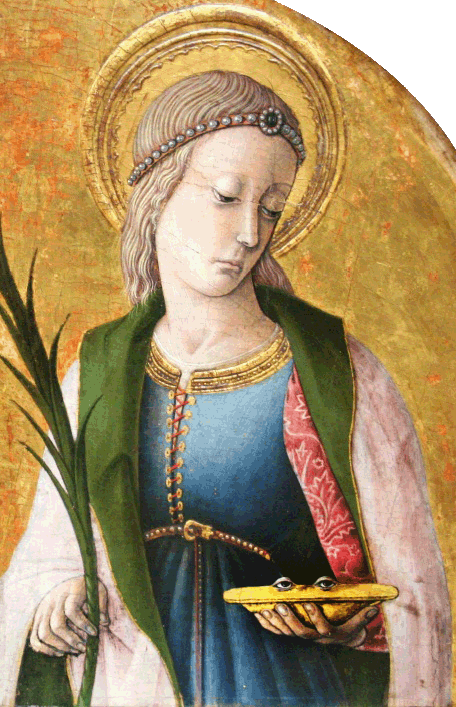An oleograph from the 19th century pictures the entire narrative in twelve scenes arranged around an image of the saint.
PORTRAITS
Originally St. Lucy's attribute was a flaming lamp, as in the first picture at right. The lamp referenced both her name (which means "light") and literary works that associated her with the "wise virgins" who kept their lamps ready for the bridegroom in Matthew 25:1-13. Some images also added a knife or sword as an attribute supplemental to the lamp (example).But by at least the 12th century St. Lucy came to be invoked for diseases of the eye, and her most common attribute became a pair of eyes placed on a golden plate (as in the second picture at right) or held delicately between her fingers (example).1 There is nothing about eyes or eyesight in the early accounts of Lucy's passion, or even as late as Bokenham's 14th century Legend of Holy Woman. But according to Cassell (74) a "later accretion of her legend" said she plucked out her own eyes because so many young men had been attracted to her by their beauty.
A dressed santo of St. Lucy in Galicia has black hair, but in all the other portraits I have examined she is a young blonde. Her own eyes are always intact, despite a literary tradition that started to appear at the end of the 15th century claiming the saint had gouged out her eyes in order to be undesirable to young men who had admired them. That tradition drew credibility from the eyes-on-a-plate attribute and also from Jesus' admonition, "if thy right eye scandalize thee, pluck it out and cast it from thee" (Matthew 5:29).2
Prepared in 2014 by Richard Stracke, Emeritus Professor of English, Augusta University.
HOME PAGE

From 1330, Jacopo del Casentino's portrait of St. Lucy with her original attribute, a flaming lamp. In many portraits the lamp is shaped like this one. (See the description page.)

The eyes on the golden plate: detail from Carlo Crivelli's Saints Anthony and Lucy, circa 1470. (See the description page.)
ATTRIBUTES
- Flaming lamp
- Eyes on a plate or in her hand
MORE IMAGES
- 12th century: In "Icon and Narrative" Cynthia Hahn analyzes the images in a small book comprising texts and images of Lucy and her passion.
- 16th century: In Anthony of Padua's fresco, Saints Paul and Lucy St. Lucy holds a book and a golden plate with the eyes.
- 16th century: In Zaganelli's portrait St. Lucy holds the eyes between her fingers.
- 1505: Perugino's painting retains the older iconography of the flaming lamp.
- 1526: Antonello Gagini's statue of St. Lucy holding the chalice of fire, with a narrative frieze along the base.
- 1536: In one of Bassano's Madonna paintings St. Lucy offers her palm branch to the Christ Child while a namesake, little Lucia Soranzo, plays with her dog.
- Late 16th or early 17th century: St. Lucy takes a dramatic stance in Palma il Giovane's St. Nicholas altarpiece.
- 18th century: Gaspare Serenario, The Last Communion of St. Lucy.
- 1747-48: Tiepolo's painting of St. Lucy's last communion in a contemporary setting.
- Undated: A portrait of St. Lucy in Barcelona with a palm branch and the pair of eyes on a plate.
- Undated: A statue in the crypt of St. Domnius Cathedral, Split, Croatia.
- Undated: A fresco of St. Lucy with Saints Veronica and Apollonia.
DATES
- Feast day: December 13
BIOGRAPHY
- Golden Legend #4: html or pdf
- Dante: Inferno II:97-108, Purgatorio IX:52-63, Paradiso XXXII:100-102.
- "Saint Lucy" in Bokenham, 167-74
- Aldhelm: The sections on St. Lucy in De Laudibus Virginum, 55-56 and 186-7
- Roman Breviary, I, 653-54 (Latin text of 1632: 784-87).
RECOMMENDED
- Barbara Wisch, "Seeing is Believing: St. Lucy in Text, Image, and Festive Culture."
NOTES
1 Wisch, 104, 106-109. Hahn, 77. Cassell, 79-80.
2 Wisch, 117-19. Butler IV, 549. Duchet-Suchaux, 220. Molanus, 395, attributes the story of the gouged eyes to "Gothic" popular piety.